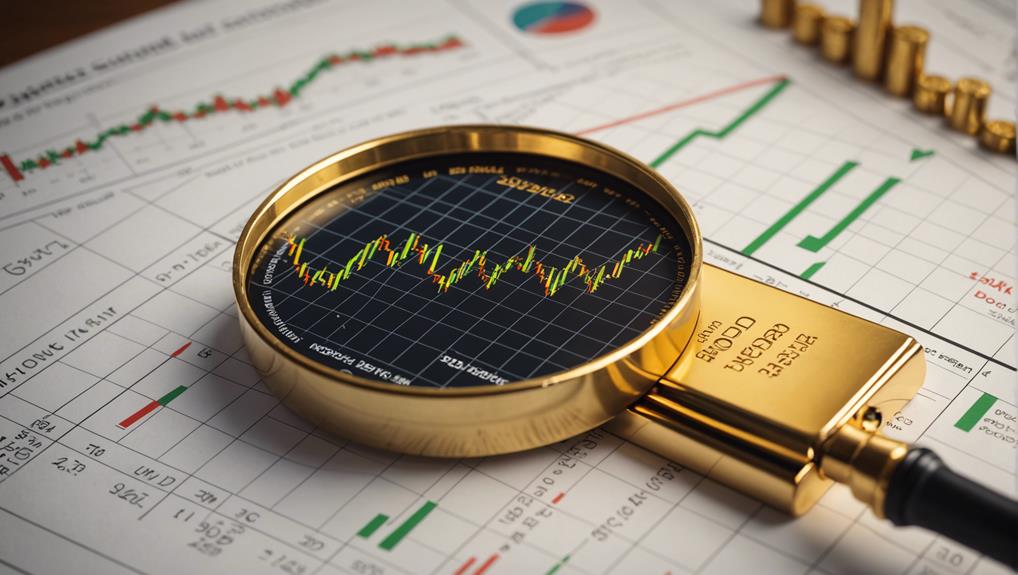Considering diversifying your investment portfolio? Gold is a fascinating option. Often seen as a safe-haven asset, gold can protect against market volatility.
As a beginner, you should understand why gold holds this reputation and explore the various ways to invest in it, from physical purchases to financial instruments like ETFs and futures.
Deciding which method suits you best involves weighing potential risks and rewards. Understanding these key elements will help you make an informed decision.
Our Quick Summary
- Allocate 5-10% of your investment portfolio to gold for diversification.
- Consider options like physical gold, gold ETFs, gold futures, and gold mining stocks.
- Gold serves as a safe haven during market volatility and economic downturns.
- Keep an eye on factors such as US dollar strength, interest rates, and geopolitical events.
- Regularly review and adjust your gold investments to meet your financial goals.
Basics of Gold Investment

Investing in gold can help diversify your portfolio and provide a safeguard against market downturns. Gold investment is crucial for diversification, acting as a safe haven asset during economic uncertainties.
Historical returns show resilience, with a 9.1% year-over-year price increase in June. Effective risk management in your portfolio allocation includes gold, which buffers against severe market fluctuations.
Adopting a dollar-cost averaging strategy—investing a fixed amount regularly—helps manage price volatility. Incorporating gold into your investment strategy requires balancing risk tolerance and long-term goals.
Understanding how gold can stabilize your investments strengthens your portfolio's resilience and better equips you to navigate financial uncertainties.
Ways to Invest in Gold
Whether you're a seasoned investor or just starting out, there are several ways to invest in gold, each offering unique benefits and considerations. Physical gold, such as bullion and coins, represents tangible assets you can hold.
Gold ETFs allow you to invest in gold without the need to store physical assets, providing both liquidity and lower costs. Gold futures, contracts to buy or sell gold at a future date, can be highly speculative and involve greater risk.
Investing in gold mining stocks or gold mutual funds ties your investment to companies involved in gold extraction, offering potential for dividends and capital appreciation. Gold certificates represent ownership without the need for physical possession, adding a layer of convenience.
Gold IRAs are specialized retirement accounts focusing on gold investments, providing a way to include gold in your long-term financial planning.
Each option has its own appeal and risks, requiring careful consideration based on your investment goals and risk tolerance.
Advantages and Risks

Gold shines as a safe haven during market volatility, offering a hedge against economic uncertainties. Central banks often hold gold, reflecting its stability.
As an inflation hedge, gold preserves purchasing power when prices rise. However, gold investments can be volatile and don't generate income like stocks or bonds. Considering market sentiment and your investment horizon is essential before investing.
Physical possession of gold adds security but involves storage costs. Being a tangible asset, gold minimizes counterparty risk.
Effective investment strategies include diversifying with gold to balance portfolio risks. Thoughtful planning is crucial, and typically, investors allocate 5-10% to gold for optimal diversification.
Determining Portfolio Allocation
To determine your portfolio's gold allocation, start by assessing your risk tolerance and financial goals. Financial experts typically recommend allocating 5% to 10% of your portfolio to gold for diversification and risk mitigation.
Consider your investment horizon and how gold's performance during economic downturns fits into your strategy. Regularly review and adjust your gold allocation based on market conditions and your risk appetite.
Aligning your gold investments with your financial goals and current market trends can help manage economic fluctuations and achieve a balanced portfolio.
Factors Influencing Prices

Several critical factors influence gold prices, making it essential to understand the dynamics at play.
The strength of the US dollar often has an inverse relationship with gold prices; a stronger dollar usually leads to lower gold prices.
Interest rates and central bank policies also significantly impact gold prices. Lower interest rates tend to boost gold prices, while central bank policies can either support or suppress them.
Demand for physical gold, particularly from China and India, drives price fluctuations.
Market sentiment, shaped by investor behavior, can sway gold prices based on perceived risks and opportunities.
Global events and geopolitical tensions create uncertainty, prompting investors to turn to gold as a safe-haven asset, thereby affecting its price.
Buying and Storing Gold
When purchasing physical gold, consider factors such as karat purity, secure storage, and insurance for protection.
Gold bars and jewelry can be bought, but higher karat purity, like 21 karats or more, ensures better value despite being less durable.
Storing your gold securely is vital; account for storage and insurance costs to protect your investment.
Understanding the spot price and bid price helps gauge market liquidity and make informed decisions.
Key considerations include:
- Karat Preference: Higher purity means better value.
- Storage Costs: Safekeeping your gold incurs expenses.
- Insurance Costs: Essential for investment protection.
- Market Liquidity: Timing for buying or selling matters.
Proper storage is crucial to maintaining your gold reserves.
Conclusion
Investing in gold provides a reliable way for beginners to diversify and protect their portfolios. Allocating 5-10% of your investments to gold can enhance resilience against market volatility and inflation.
Consider options like physical gold, ETFs, or mining stocks to determine the best fit for your needs. Pay attention to factors influencing gold prices and select secure storage methods.
With careful planning and informed decisions, gold can be a valuable addition to your investment strategy.






